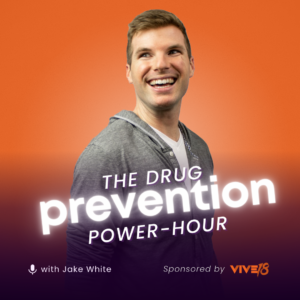“Unlocking Hidden Resources: How to Access Title IV Funding for Youth Drug Prevention Programs”
What if I told you that there is anywhere from $10,000 to $30,000, sitting in your local Board of Education or your state educational department, waiting for you to use it for drug prevention? It’s sounds incredible. It sounds too good to be true. But that doesn’t good news. It is not too good to be true. In fact, I’m going to share a program with you today. So welcome to this episode of Party Talk. I’m your host, Jake White.
There are resources available for you!
And today, we’re going to empower you by sharing how do you actually get funds to your programs, to your schools coalition’s? Whatever your organization is, if you’re investing in young leaders in the schools, doing drug prevention, changing the climate for the students to make it a better learning environment, you have resources available. And I hear this all the time from schools, they’re emailing us saying, Hey, your program is incredible, we want to bring you in, we have no money. And listen, I would love to travel the country helping students for free, it’s just not possible. So I like to point them to resources, just like you like to point people to resources in your local community. Because in order to make a difference, we have to find what tools are available to us. So this can help you if you’re looking to bring in a program, a curriculum, a speaker, if you have a big dream, to really make a dent, and make an impact in your community, you know, it’s going to take resources, it’s going to take partners, and today’s topic of title four funding is going to help you pull this off. And if you stick around to the end, I will give you one more tip, another place where you can find a very similar program and resource available where you can find even more money to help pursue your mission and save more lives. So let’s dive right into it.
Title Four funding with priority content.
Today, we’re talking about title four funding. Now, let’s nerd out a little bit, I’ve opened up some some things about this, they can allow us to deep dive in it. So basically, in the past, you might have heard of things like the safe and Drug Free Schools Program, or no child left behind. And the aim was to build a better school environment so that everyone could be a part of a great learning experience, even if we learn differently. So the government had set aside grant money that schools could apply for, and they basically changed up the platform. And title for is, has basically three aims. Here’s what it is to provide all students with access to a well rounded education, that’s one. Two, or to improve school conditions for student learning, that’s two. and then to improve the use of technology in order to improve the academic achievement, and digital literacy of all students, that’s three. And when it comes to those three categories, they’re called priority content areas, the things in the activities to support well rounded educational opportunities. It’s things like college and career guidance, counseling programs, music and arts, science, technology, you know, stem, accelerated learning programs, foreign language, environmental education, volunteerism, and community involvement. And those might be helpful to you already, you might have something where you’re like, Hey, we are trying to do something with music and arts education. As a prevention strategy. You might be looking at environmental education, volunteerism and community involvement. That can be something that you’re wanting to pour into the second category, this is the one that’s really on target.
Who is Title IV funding for?
For anybody listening to this if you are a school principal, a counselor, a social worker, a school therapist, or psychologist, and you’re looking to dive into drug prevention and education. This one is for you. The topic or category is activities to support Safe and Healthy Students. All right, now check this out. This is awesome. It says it right here on this page. It says note activities support to support Safe and Healthy Students may be conducted in partnership with institution of higher education businesses, nonprofit organizations, community based organizations, or other public or private entities with demonstrated records of state Access and implemented these access at these activities. So check this out that already this is you, you know, this is you. And here are the things that they want to address suicide prevention, trauma informed practices in classroom management, crisis management and conflict resolution, human trafficking, school based violence prevention strategies, drug abuse prevention, bullying and harassment prevention, sexual abuse awareness and prevention, and positive behavior, intervention and supports. This is you. Right there, you’ve already I don’t know how many minutes we are in, but this is going to be the quickest and most impactful episode to date probably for you. So if this has already been helpful, go ahead and shoot the link over to a friend who does drug prevention over to a principal or a counselor or somebody that you work with, and that this information is going to be helpful to. The final one is the activities to support the effective use of technology. The bullet points under this that you can use it for are promoting professional learning for educators, building technological capacity and infrastructure developing are using effective or innovative strategies for the delivery of academic content through the use of technology. Or number four, providing students in rural remote and underserved areas, expanded access to educational opportunities through technology. So those are the three main areas. The one that’s a whole run for you is that second one. And here’s what I’ll say. If you’re like, Yes, Jake, this is awesome, is incredible. How do I go about finding and applying for this? Realize that number one, as long as you’re a local entity that works in education, you can apply for these funds. You don’t have to be a public school, you can be a charter school or private school. There I have a list. See here, the the people that can apply for this, parents, teachers, principals, students, school leaders, charter schools, specialized instructional support personnel, tribal organizations, local government representatives. Other relevant it says others with relevant and demonstrated expertise. And community based organizations like this is anyone, if you’re going to help improve education for young people in your organization that serves them, you can apply for these files, it’s incredible. What I would recommend doing because how the program works is it goes from the federal government program down to the state and then down to the local educational agencies is get in touch with whoever is maybe your local superintendent, see what they know know about it. So call them up and say, Hey, we’ve got an idea we want to do this. Do you know how we can get some title four funds. The other options is if you have like a county or a state board of education, ask them most likely the funds have gone through their organization or are sitting in their organization waiting for it to be used.
What is Title 1 funding and who qualifies?
With that said, the bonus I want to give you before we end this episode is there’s another title handloads call it there’s another program. And it’s called title one funding. And if you’re thinking, Hey, listen, like our organizations just don’t have that much money. Maybe we’ve used all our title for funds for the year. There’s another one called title one funding. And this is specifically given to communities that are if more than 40% of the students are classified as coming from low income family families, then this is going to help you because you get this special fund to impact your schools. And here’s what it says when I’m reading about it online is so it comes from the Elementary and Secondary Education Act II s EA. It was signed back in 1965. And here’s what it says. All right. So it’s a program that goes through the US Department of Education. It distributes funds to schools and school districts, title one target schools where a high percentage of students are from low income families. The purpose is to help schools establish program to help these students programs that wouldn’t be possible without this outside funding.
And so it goes through the same I guess funnel from you know, the US Department of Education, the state Some educational agencies and then a local educational agencies, and then your public school, a charter school or organization can apply to them through, you know, whoever is closest to you, once again, if the ones who are eligible who receive this is that the ones that at least 40% of the students are from low income families based on the US Census and US Census definition for low income. So you should be able to check, what can be used for that. And if you apply for those kinds of things, if you’re a title one school.
Let’s dream bigger for our students and encourage them to change the world.
Alright, I hope this was helpful, I hope that you can apply for some of these funds to bring in some of the programs and achieve this dream you have for helping students because, honestly, I think that I think that we could dream bigger. Again, our field, there is a really low bar for what we can do, and what we think students are capable of. But what I’m seeing with Gen Z is they absolutely want to change the world. And if we can show them how big they can dream by modeling it for them, we can do some pretty incredible stuff. And you might some see some people across the country who are doing incredible work. And what I’ve noticed about them is they know how the system works. They know how to go after funding and opportunities so that when they have a big dream, they don’t get scolded or birds on it by, you know, not being able to pursue that tree. Instead, they have a great experience, because they’ve got this big dream, they’re able to bring in different partners, and then they pull it off. And when they do that the students see what difference they make. And they want to be a part of it. They want to follow suit. And that’s what’s going to change the world. Students getting into this work, seeing adults who are eager to give them learning opportunities and leadership opportunities. That’s going to absolutely change this world and change a culture for the better. So keep doing the incredible work that you’re doing. If you found this valuable. share this episode with someone in education. And we’ll see you on another episode of Party Talk where we empower leaders in youth job prevention.


